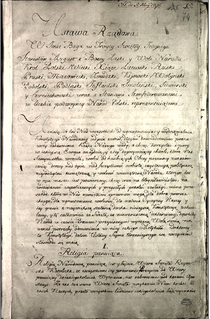 W
WThe Great Sejm, also known as the Four-Year Sejm was a Sejm (parliament) of the Polish–Lithuanian Commonwealth that was held in Warsaw between 1788 and 1792. Its principal aim became to restore sovereignty to, and reform, the Commonwealth politically and economically.
 W
WBlack procession was a demonstration held by burghers of Polish royal cities in Polish-Lithuanian Commonwealth's capital of Warsaw on 2 December 1789, during the Great Sejm. It vastly contributed to the passage of a belated major urban reform.
 W
WThe Constitution of 3 May 1791, titled the Governance Act, was a constitution adopted by the Great Sejm for the Polish–Lithuanian Commonwealth, a dual monarchy comprising the Crown of the Kingdom of Poland and the Grand Duchy of Lithuania. The Constitution was designed to correct the Commonwealth's political flaws. It had been preceded by a period of agitation for—and gradual introduction of—reforms, beginning with the Convocation Sejm of 1764 and the ensuing election that year of Stanisław August Poniatowski, the Commonwealth's last king.
 W
WThe Free Royal Cities Act was an act adopted by the Four-Year Sejm (1788–92) of the Polish-Lithuanian Commonwealth on April 18, 1791, in the run-up to the adoption of the Constitution of May 3, 1791. The Act was subsequently incorporated in extenso into the Constitution by reference in its Article III.
 W
WKołłątaj's Forge was a group of social and political activists, publicists and writers from the period of the Great Sejm in the Polish-Lithuanian Commonwealth.
 W
WThe Patriotic Party, also known as the Patriot Party or, in English, as the Reform Party, was a political movement in the Polish–Lithuanian Commonwealth in the period of the Four-Year Sejm of 1788–92, whose chief achievement was the Constitution of 3 May 1791. The reformers aimed to strengthen the ailing political machinery of the Commonwealth, to bolster its military, and to reduce foreign political influence, particularly that of the Russian Empire. It has been called the first Polish political party, though it had no formal organizational structure. The Party was inspired by the ideals of the French Revolution, and its name, proudly used by themselves, was a tribute to the Dutch Patriots.
 W
WThe Reciprocal Guarantee of Two Nations was an addendum to the Polish Constitution of May 3, 1791, adopted on 20 October 1791 by the Great Sejm, which stated implementing principles that had not been spelled out in the constitution. The document specified the nature of the Polish–Lithuanian union and affirmed "the unity and indivisibility" of the Crown of the Kingdom of Poland and the Grand Duchy of Lithuania within a single state.
 W
WThe Targowica Confederation was a confederation established by Polish and Lithuanian magnates on 27 April 1792, in Saint Petersburg, with the backing of the Russian Empress Catherine II. The confederation opposed the Constitution of 3 May 1791, which had been adopted by the Great Sejm, especially the provisions limiting the privileges of the nobility. The text of the founding act of the confederation was drafted by the Russian general Vasili Stepanovich Popov, Chief of Staff of Prince Grigori Alexandrovich Potemkin. Its purpose was proclaimed in the small town of Targowica and the Potocki's estate on May 14, 1792. Four days later two Russian armies invaded the Polish-Lithuanian Commonwealth without a formal declaration of war.